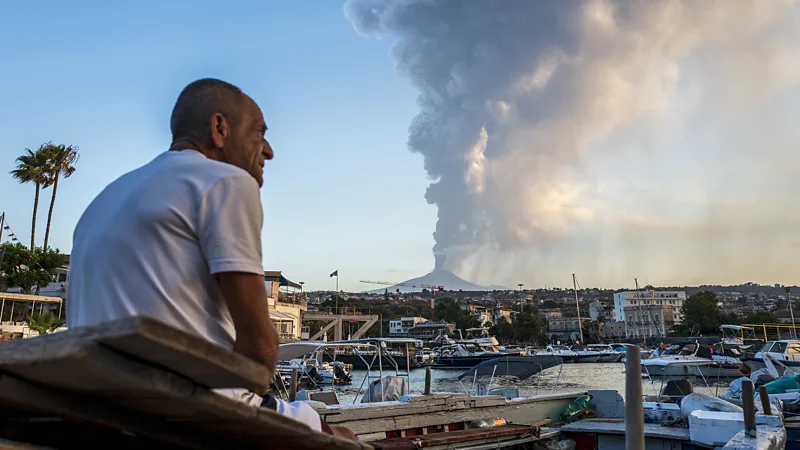Why scientists are excited about Italy's volcanoes
As volcanic activity continues at Mount Etna, Chris Baraniuk explores why Mount Etna and Mount Stromboli are becoming more lively.

The top of the volcano exploded, sending a gigantic column of ash four or five kilometres (2.5-3 miles) into the sky. Mount Stromboli, off the north coast of Sicily, is one of the most active volcanoes in the world. On 11 July, it produced a paroxysm – a term in geology for a type of powerful eruption that interrupts a period of milder volcanic activity. In the villages nestled around the foot of the volcano, warning sirens blared.
The paroxysm occurred shortly after 2pm local time and news of the event quickly began to spread online. Shortly after the explosion, two dozen or so volcanologists around Europe were due to attend one of their regular meetings. Chiara Maria Petrone, a volcano petrologist at the Natural History Museum in the UK, joined the session online.
"We started the meeting just an hour after the paroxysm," she recalls. "It was really exciting."
Immediately, the scientists began bringing each other up to speed. Some shared real-time data from seismometers and other instruments. A few attendees even happened to be on the island of Stromboli at the time, according to Petrone, meaning they were able to describe what they were seeing. "It was all just happening at that moment," says .
Paroxysms at Mount Stromboli are relatively rare. The last such eruption occurred five years ago in 2019, and caused the death of a hiker. But July 2024 turned out to be a very busy month for volcanologists in Italy because nearby Mount Etna, on the east coast of Sicily, also erupted on 4 July and violent activity there, including giant lava fountains at the summit, continues.
Stromboli and Etna are among the best-studied volcanoes in the world. Reports of their eruptions date back centuries. Today, both peaks bristle with sensors that listen to the vibrations these angry giants produce. The two volcanoes are also frequently photographed by thermal cameras, drones and satellites. Some of this information feeds into experimental early warning systems, which try to predict strong eruptions shortly before they occur. But these volcanoes are also changing all the time, and there are signs that violent paroxysms at Stromboli could become more frequent.
The exercise we led before the paroxysm actually occurred in real life 10 days later – Valentin Freret-Lorgeril
The Stromboli paroxysm earlier this summer was not entirely unexpected. Petrone visited the volcano in May and witnessed slightly heightened activity even then. "There was already a high level of attention and monitoring – probably more than usual," she says. Scientists are still gathering data about the 11 July event but Petrone says early indications are that it was not quite as large as the two paroxysms that happened in 2019, which she has studied in detail.
She is now itching to get her hands on pieces of hard, cooled magma ejected by the latest eruption. Her specialism involves studying the composition of these rocks to understand the processes that go on inside volcanoes and how specific eruptions unfold. "They are sending me the samples," she says, referring to her colleagues in Italy.
That both Etna and Stromboli are erupting at the same time really is just a coincidence, stresses Valentin Freret-Lorgeril, a volcanologist at the University of Auvergne in France. He says that he has seen some comments on social media suggesting the eruptions are somehow linked and that some kind of catastrophe is unfolding – but this is not true. The geology that drives Etna is distinct from that of Stromboli, though they are both in a region that has multiple volcanoes. Stromboli is the result of one tectonic plate pushing beneath another whereas Etna appears to be caused by a stretching of the Earth's crust, which allows magma to rise to the surface, says Freret-Lorgeril.
The nature of the eruptive activity occurring at both Mount Etna and Mount Stromboli can be labelled "Strombolian", meaning a continuous, moderate kind of activity that occasionally produces larger paroxysms. This is different from "Vulcanian" activity, for example, says Freret-Lorgeril. In the latter, volcanoes erupt after gases and thick magma build up in pressure beneath a cap or plug, eventually blowing through this barrier. Strombolian activity is a bit more fluid – like a pot on the boil, or bubbles of gas coming to the surface in a container of liquid. "You have a large amount of gas and magma," explains Freret-Lorgeril. "When the bubble arrives at the surface, it will explode."
Freret-Lorgeril and his students visited Stromboli at the start of July and took part in an unexpectedly prophetic roleplaying activity based on a hypothetical large eruption at the volcano. "The exercise we led before the paroxysm actually occurred in real life 10 days later," he says.
The early warning system data did point to a paroxysm in the days ahead of the 11 July eruption, notes Freret-Lorgeril. And he points out that scientists can tell such an event might be imminent by tracking the shape of the volcano from the outside. Changes in the profile of one side of the mountain, for instance, could signal that it is getting ready to blow. "Tracking these deformations is really important because you can say, 'OK, there might be an increase in [magma] volume in the magmatic chamber'," explains Freret-Lorgeril.
And volcanoes do change shape drastically sometimes. Etna's recent eruptions have had the startling effect of increasing the height of the volcano by several metres. There are four craters at the summit and during the latest eruptions one of these craters, called Voragine, has grown taller thanks to the piling up of magma at the top of Etna. Voragine has now reached a height of 3,369m (11,053ft), clearly exceeding the height of the next-tallest crater, at 3,354m (11,003ft). This summit-building is one of the remarkable ways in which volcanoes change over time and scientists monitor such developments closely. But it does mean that sensors on top of these lively peaks – for example those that detect gases produced by the volcano – often get destroyed as hot magma accumulates. "You have to replace them," says Freret-Lorgeril. "It is expensive."
Activity at Stromboli is "fairly well understood", says Jenny Suckale, an associate professor in geophysics at Stanford University. Though "sometimes Stromboli surprises us by doing something more radical", she says. Occasionally, for instance, eruptions occur on the side of the volcano. These can be very dangerous as they can cause landslides, potentially threatening the villages below. Landslides that cascade into the sea on this island, which is very popular with tourists, risk producing tsunamis that can capsize boats. A tsunami caused by volcanic activity at Stromboli in December 2002 damaged buildings and smashed into a tanker ship, resulting in a small oil spill.
Can we predict volcanic eruptions?
Scientists still have lots of questions about how eruptions at Stromboli unfold. In 2022, Petrone and colleagues discovered evidence for a recent change in the inner workings of the volcano – an alteration of its "plumbing system", as she puts it. No-one knows exactly how the inside of the volcano is structured but scientists are pretty confident that there are two internal magma reservoirs, a shallow one and a deep one. The deeper magma can be identified by the fact that it contains less silica and more magnesium than the shallower magma. "It's more pristine, if you want," says Petrone. When this deeper magma blasts up and out of the top of the volcano during a paroxysm, it mixes slightly with the material in the shallower reservoir.
Petrone and her colleagues analysed cooled magma rocks left by the paroxysms in 2019. Using an electron microscope, the researchers made images of these rocks to study the crystals inside them. The images revealed dark layers within these masses of crystals – that's the deeper magma. Since there was a sharp distinction between darker and lighter layers of these crystals, rather than a fuzzy contrast between the two, Petrone says the deeper magma mixed with the shallower magma only shortly before the eruption, quickly forming a layer and then blasting out of the top. "This clearly tells me that the arrival of this deeper magma is [what] triggered the two paroxysms in 2019," adds Petrone.
And it also hints that the deeper magma could be finding it easier to move upwards in Stromboli, potentially meaning that paroxysms will be more likely in the coming years.
Freret-Lorgeril notes that historical records of eruptions at Stromboli suggest the volcano used to be even more active than it was for much of the 20th Century. "Perhaps, since 2019, Stromboli is showing us its true face, let's say," he says.
It's hard to know exactly why the deeper magma might be finding it easier to move upwards in the volcano though, notes Suckale. And experts still don't know whether this new behaviour will become more prevalent over time. If only we could look inside Stromboli to find out what's going on in greater detail.
Because the insides of volcanoes are so hot – potentially well in excess of 1,000C (1,832F) – it's generally not possible to study them internally. However, in the past, some researchers have suggested dropping heat-resistant radio transmitters into volcanoes – devices which could resist the heat for long enough to take measurements of the gases found inside and relay the information to volcanologists in real time
Perhaps tiny heat-tolerant robots will one day explore the innards of volcanoes such as Stromboli, slowly swimming through crevices packed with magma and rock. "I would love that – oh my goodness," says Suckale at the idea. There's no real alternative if you want to get inside. "You can't drill into it. You risk exploding the whole thing – and you don't want to do that," she adds.
Absent volcano-bots, scientists will have to make do with the huge array of other equipment they currently use to study volcanoes such as Stromboli and Etna from the outside. Petrone, for one, is anxious to find out what the rock ejected from Stromboli last month is like.
"My colleague told me that probably this deeper magma has been erupted," she says, excitedly. "So it's time to have a look."
-BBC







